Effect of Organic and Synthetic Fertilizers on Nitrate, Nitrite, and Vitamin C Levels in Leafy Vegetables and Herbs
Abstract
:1. Introduction
2. Results
2.1. Vegetables and Herbs in Northern Vietnam
2.2. Vegetables in Kanto Region of Japan
2.3. Daily Intake of Nitrogen Compound and Vitamin C of Studied Vegetables
3. Discussion
3.1. Vegetables in the Northern Vietnam
3.1.1. Nitrate Content
3.1.2. Nitrite Content
3.1.3. Vitamin C Content
3.2. Vegetables in the Kanto Region of Japan
3.2.1. Nitrate Content
3.2.2. Vitamin C Content
3.3. Risk Assessment of the Effects of Nitrate, Nitrite, and Vitamin C in the Studied Vegetables on Human Health
4. Materials and Methods
4.1. Samples
4.2. Nitrate and Nitrite Analysis
4.3. Vitamin C Analysis
4.4. Risk Assessment
- 0.15: nitrate reduction obtained through washing.
- 0.50: nitrate reduction obtained through heat treatment.
- 0.05: conversion rate of nitrate to nitrite.
4.5. Statistical Analysis
5. Conclusions
Future Perspectives
Author Contributions
Funding
Data Availability Statement
Acknowledgments
Conflicts of Interest
References
- Habibi, N.; Tayobong, R.R.P.; Naoki, P.; Atsushi, T.; Kaihei, S. Novel Insights into Seed Priming for Tomato Plants: Restoring Root Vitality in the Face of Salt Stress. Hortic. Environ. Biotechnol. 2024. [Google Scholar] [CrossRef]
- Slavin, J.L.; Lloyd, B. Health Benefits of Fruits and Vegetables. Adv. Nutr. 2012, 3, 506–516. [Google Scholar] [CrossRef]
- Septembre-Malaterre, A.; Remize, F.; Poucheret, P. Fruits and Vegetables, as a Source of Nutritional Compounds and Phytochemicals: Changes in Bioactive Compounds during Lactic Fermentation. Food Res. Int. 2018, 104, 86–99. [Google Scholar] [CrossRef] [PubMed]
- Nga, N.T.T.; Bac, N.X.; Hanh, V.T.; Ha, L.T.N. Polyphenols from Tropical Almond Leaves (Terminalia catappa L.): Optimized Extraction Conditions and α-Glucosidase Inhibitory Activity. Vietnam J. Agric. Sci. 2024, 7, 2064–2075. [Google Scholar] [CrossRef]
- Nguyen, T.T.N. Process for Extraction of Glucosinolates from By-Products of White Caggabe (Brassica oleracea var. capitata f. alba). Vietnam J. Agri. Sci. 2016, 14, 1035–1043. [Google Scholar]
- Walters, C.L.; Smith, P.L.R. The Effect of Water-Borne Nitrate on Salivary Nitrite. Food Cosmet. Toxicol. 1981, 19, 297–302. [Google Scholar] [CrossRef]
- Wang, Y.; Chen, W.; Zhou, J.; Wang, Y.; Wang, H.; Wang, Y. Nitrate Metabolism and Ischemic Cerebrovascular Disease: A Narrative Review. Front. Neurol. 2022, 13, 735181. [Google Scholar] [CrossRef]
- Garnacho-Castaño, M.V.; Sánchez-Nuño, S.; Molina-Raya, L.; Carbonell, T.; Maté-Muñoz, J.L.; Pleguezuelos-Cobo, E.; Serra-Payá, N. Circulating Nitrate-Nitrite Reduces Oxygen Uptake for Improving Resistance Exercise Performance after Rest Time in Well-Trained CrossFit Athletes. Sci. Rep. 2022, 12, 9671. [Google Scholar] [CrossRef]
- Walters, C.L. Nitrate and Nitrate in Foods. In Nitrates and Nitrites in Food and Water; Ellis Horwood: Chichester, UK, 1991; pp. 93–113. [Google Scholar]
- Alexander, J.; Chen, J.; Dagher, S.M.; Hattan, D.G.; Kawamura, Y.; Knaap, A.G.A.C.; Kuznesof, P.M.; Larsen, J.C.; Meyland, I.; Pascal, G.; et al. Evaluation of Certain Food Additives. In World Health Organization Technical Report Series; World Health Organization: Geneva, Switzerland, 2002. [Google Scholar]
- Jackson, J.; Patterson, A.J.; MacDonald-Wicks, L.; McEvoy, M. The Role of Inorganic Nitrate and Nitrite in CVD. Nutr. Res. Rev. 2017, 30, 247–264. [Google Scholar] [CrossRef]
- Correia, M.; Barroso, Â.; Barroso, M.F.; Soares, D.; Oliveira, M.B.P.P.; Delerue-Matos, C. Contribution of Different Vegetable Types to Exogenous Nitrate and Nitrite Exposure. Food Chem. 2010, 120, 960–966. [Google Scholar] [CrossRef]
- Santamaria, P.; Gonnella, M.; Elia, A.; Parente, A.; Serio, F. Ways of Reducing Rocket Salad Nitrate Content. Acta Hortic. 2001, 548, 529–536. [Google Scholar] [CrossRef]
- Bijay-Singh; Craswell, E. Fertilizers and Nitrate Pollution of Surface and Ground Water: An Increasingly Pervasive Global Problem. SN Appl. Sci. 2021, 3, 518. [Google Scholar] [CrossRef]
- Rembiałkowska, E. Quality of Plant Products from Organic Agriculture. J. Sci. Food Agric. 2007, 87, 2757–2762. [Google Scholar] [CrossRef]
- Caruso, G.; Conti, S.; La Rocca, G. Influence of Crop Cycle and Nitrogen Fertilizer Form on Yield and Nitrate Content in Different Species of Vegetables. Adv. Hortic. Sci. 2011, 25, 81–89. [Google Scholar]
- Yu, X.; Guo, L.; Jiang, G.; Song, Y.; Muminov, M.A. Advances of Organic Products over Conventional Productions with Respect to Nutritional Quality and Food Security. Acta Ecol. Sin. 2018, 38, 53–60. [Google Scholar] [CrossRef]
- Roumeliotis, C.; Siomos, A.S.; Gerasopoulos, D. Comparative Nutritional and Antioxidant Compounds of Organic and Conventional Vegetables during the Main Market Availability Period. Nitrogen 2021, 2, 18–29. [Google Scholar] [CrossRef]
- De Martin, S.; Restani, P. Determination of Nitrates by a Novel Ion Chromatographic Method: Occurrence in Leafy Vegetables (Organic and Conventional) and Exposure Assessment for Italian Consumers. Food Addit. Contam. 2003, 20, 787–792. [Google Scholar] [CrossRef]
- Guadagnin, S.G.; Rath, S.; Reyes, F.G.R. Evaluation of the Nitrate Content in Leaf Vegetables Produced through Different Agricultural Systems. Food Addit. Contam. 2005, 22, 1203–1208. [Google Scholar] [CrossRef]
- Aires, A.; Carvalho, R.; Rosa, E.A.S.; Saavedra, M.J. Effects of Agriculture Production Systems on Nitrate and Nitrite Accumulation on Baby-leaf Salads. Food Sci. Nutr. 2013, 1, 3–7. [Google Scholar] [CrossRef]
- Hogstad, S.; Risvik, E.; Steinsholt, K. Sensory Quality and Chemical Composition in Carrots: A Multivariate Study. Acta Agric. Scand. B Soil Plant Sci. 1997, 47, 253–264. [Google Scholar] [CrossRef]
- Malmauret, L.; Parent-Massin, D.; Hardy, J.-L.; Verger, P. Contaminants in Organic and Conventional Foodstuffs in France. Food Addit. Contam. 2002, 19, 524–532. [Google Scholar] [CrossRef]
- European Commission. Commission Regulation (EU) No 1258/2011 of 2 December 2011 amending Regulation (EC) No 1881/2006 as regards maximum levels for nitrates in foodstuffs. Off. J. Eur. Union 2011, L320, 15–17. Available online: https://eur-lex.europa.eu/eli/reg/2011/1258/oj (accessed on 2 September 2024).
- Vermeer, I.T.M.; van Maanen, J.M.S. Nitrate Exposure and Endogenous Formation of Carcinogenic Nitrosamines in Humans. Rev. Environ. Health 2001, 16, 105–116. [Google Scholar] [CrossRef]
- Lisiewska, Z.; Kmiecik, W. Effects of Level of Nitrogen Fertilizer, Processing Conditions and Period of Storage of Frozen Broccoli and Cauliflower on Vitamin C Retention. Food Chem. 1996, 57, 267–270. [Google Scholar] [CrossRef]
- SCF (The Scientific Committee for Food). Opinion of The Scientific Committee for Food on: Nitrates and Nitrites. In Food Science and Techniques; 38th Series; European Commission: Luxembourg, 1997. [Google Scholar]
- Li, Y.; Schellhorn, H.E. New Developments and Novel Therapeutic Perspectives for Vitamin C. J. Nutr. 2007, 137, 2171–2184. [Google Scholar] [CrossRef]
- Santamaria, P. Nitrate in Vegetables: Toxicity, Content, Intake and EC Regulation. J. Sci. Food Agric. 2006, 86, 10–17. [Google Scholar] [CrossRef]
- Menard, C.; Heraud, F.; Volatier, J.-L.; Leblanc, J.-C. Assessment of Dietary Exposure of Nitrate and Nitrite in France. Food Addit. Contam. Part A 2008, 25, 971–988. [Google Scholar] [CrossRef] [PubMed]
- Lee, S.K.; Kader, A.A. Preharvest and Postharvest Factors Influencing Vitamin C Content of Horticultural Crops. Postharvest Biol. Technol. 2000, 20, 207–220. [Google Scholar] [CrossRef]
- Pussemier, L.; Larondelle, Y.; Van Peteghem, C.; Huyghebaert, A. Chemical Safety of Conventionally and Organically Produced Foodstuffs: A Tentative Comparison under Belgian Conditions. Food Control 2006, 17, 14–21. [Google Scholar] [CrossRef]
- Shao, H.; Chu, L.; Shao, M.; Jaleel, C.A.; Hong-mei, M. Higher Plant Antioxidants and Redox Signaling under Environmental Stresses. C. R. Biol. 2008, 331, 433–441. [Google Scholar] [CrossRef]
- Amine, E.K.; Baba, N.H.; Belhadj, M.; Deurenberg-Yap, M.; Djazayery, A.; Forrestre, T.; Galuska, D.A.; Herman, S.; James, W.P.T.; M’Buyamba Kabangu, J.R.; et al. Diet, Nutrition and the Prevention of Chronic Diseases. Am. J. Clin. Nutr. 2003, 60, 644–645. [Google Scholar] [CrossRef]
- Climate and Average Weather Year Round in Ibaraki. Available online: https://weatherspark.com/y/143420/Average-Weather-in-Ibaraki-Japan-Year-Round (accessed on 2 September 2024).
- Ibaraki Climate, Japan. Available online: https://en.climate-data.org/asia/japan/osaka-prefecture/ibaraki%20-4850/ (accessed on 2 September 2024).
- Merino, L. Development and Validation of a Method for Determination of Residual Nitrite/Nitrate in Foodstuffs and Water After Zinc Reduction. Food Anal. Methods 2009, 2, 212–220. [Google Scholar] [CrossRef]
- Habibi, N.; Terada, N.; Sanada, A.; Kamata, A.; Koshio, K. Impact of Limited Irrigation on Fruit Quality and Ethylene Biosynthesis in Tomato: A Comprehensive Analysis of Physical, Biochemical, and Metabolomic Traits. Plants 2025, 14, 406. [Google Scholar] [CrossRef] [PubMed]
- Habibi, N.; Aryan, S.; Amin, M.W.; Sanada, A.; Terada, N.; Koshio, K. Potential Benefits of Seed Priming under Salt Stress Conditions on Physiological, and Biochemical Attributes of Micro-Tom Tomato Plants. Plants 2023, 12, 2187. [Google Scholar] [CrossRef]
- Nitrate in Vegetables—Scientific Opinion of the Panel on Contaminants in the Food Chain. EFSA J. 2008, 6, 689. [CrossRef]

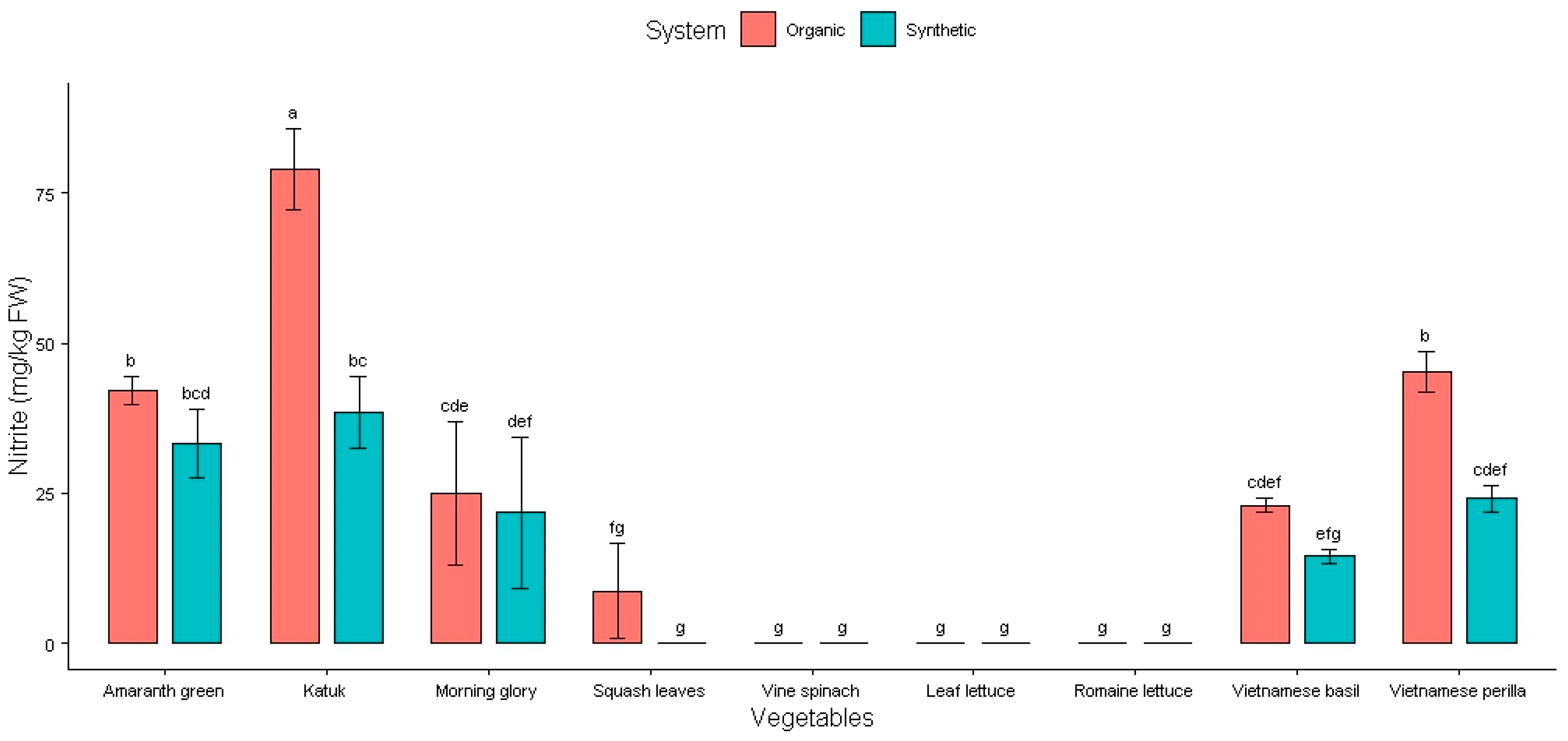
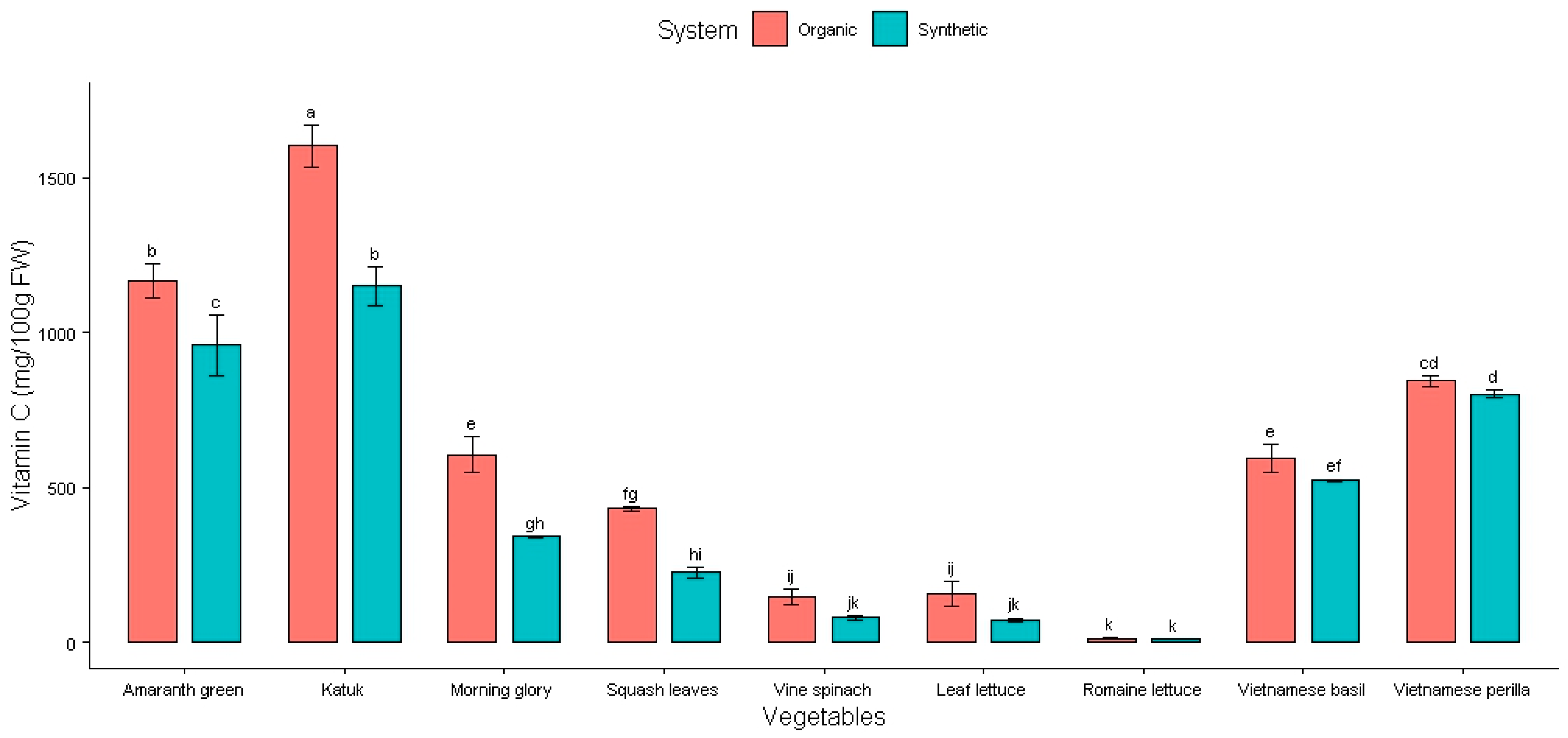

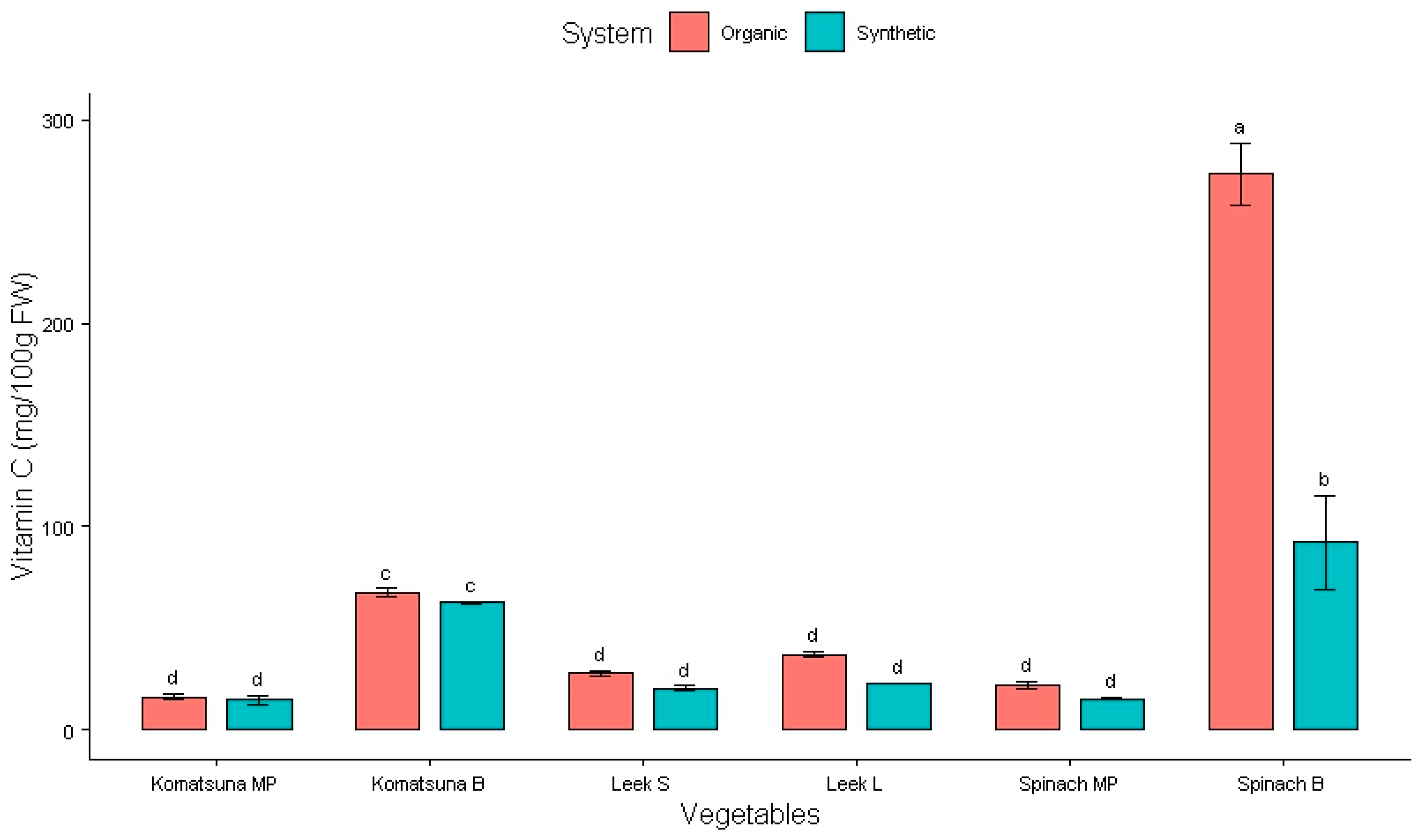
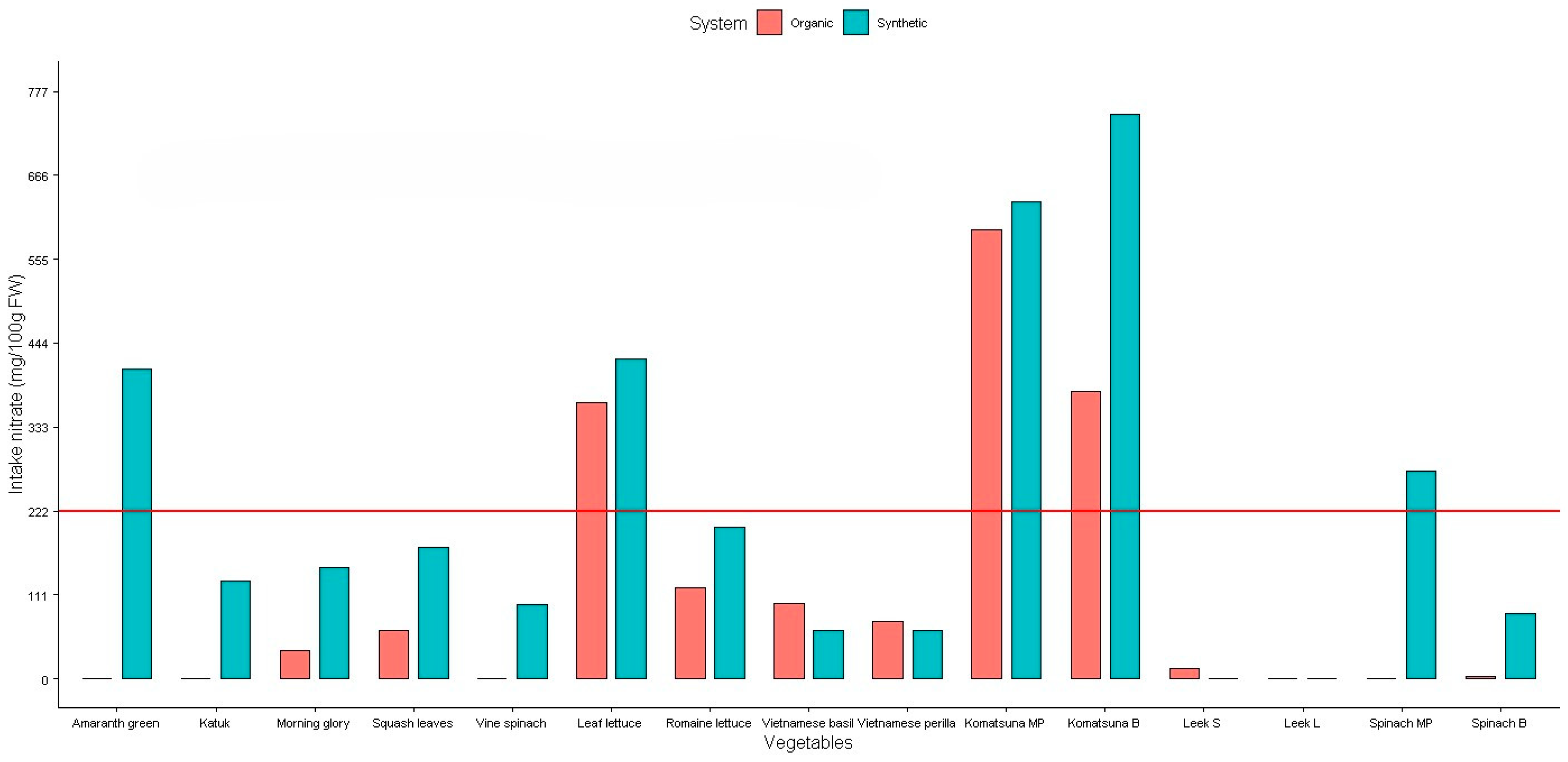
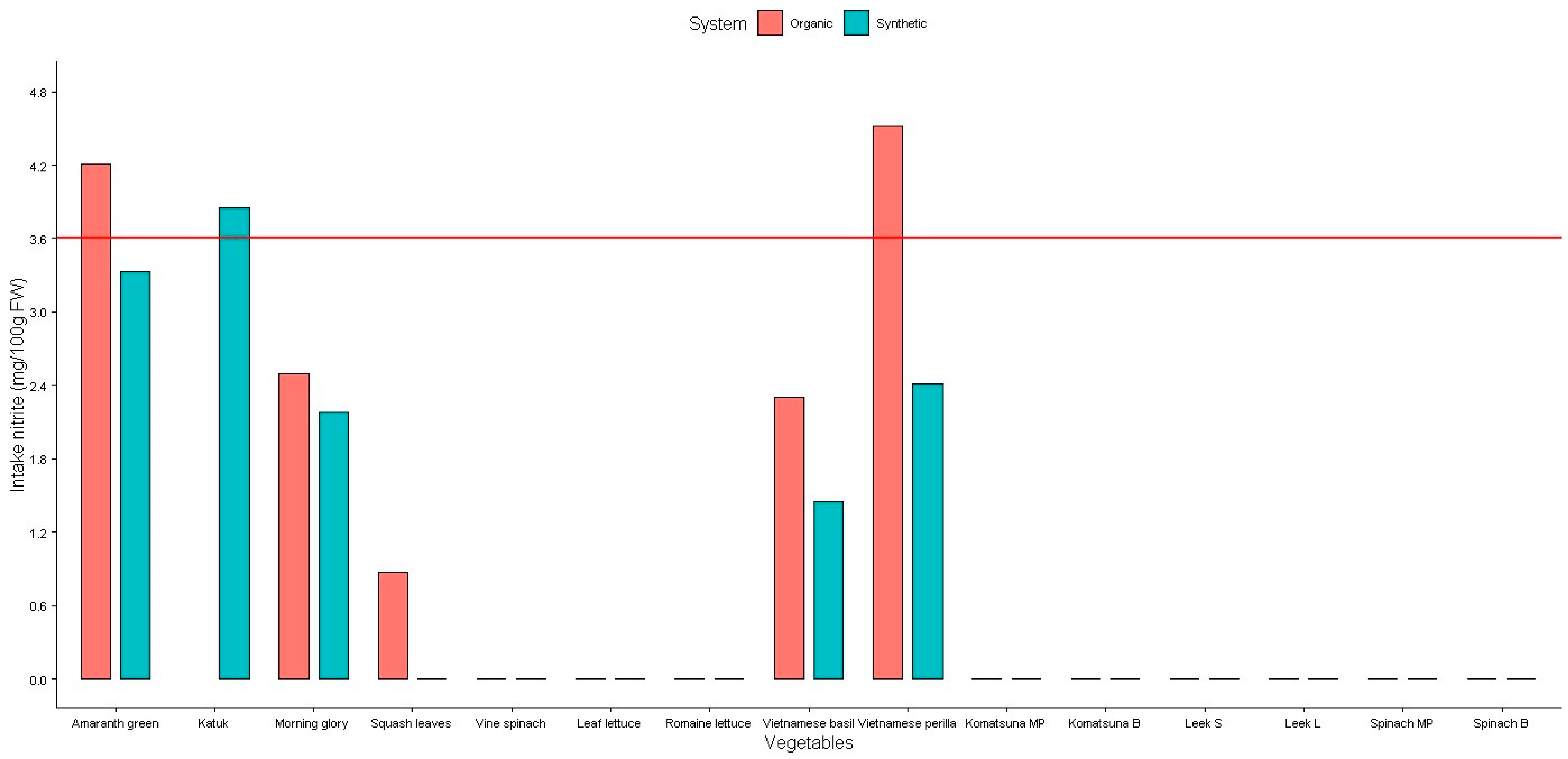
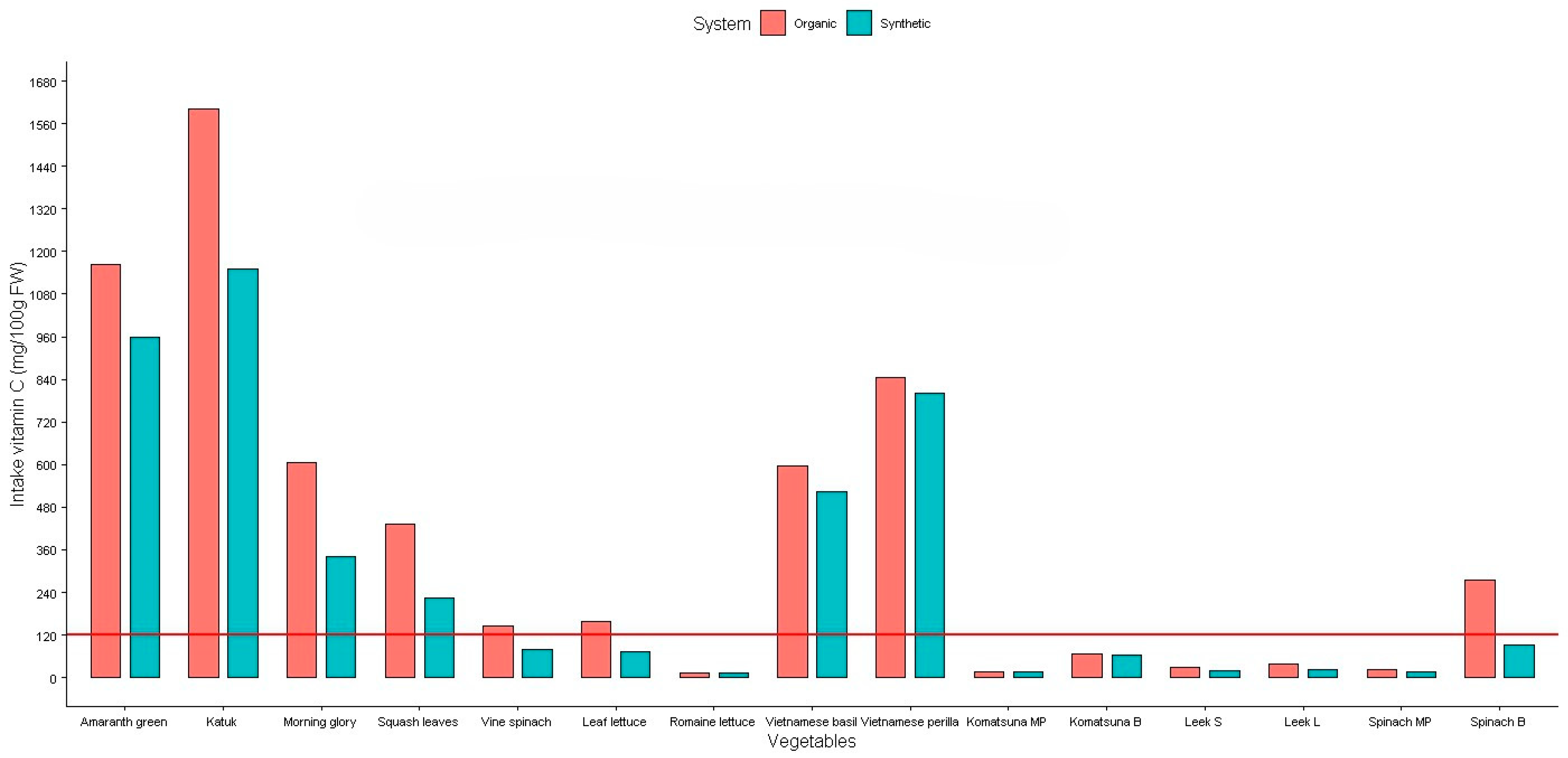

| Vegetables | Fertilizer | Nitrate Content (mg/kg FW) | |
|---|---|---|---|
| Amaranth greens | Organic | 0 ± 0 | b |
| Synthetic | 4099 ± 698 | a | |
| Katuk | Organic | 0 ± 0 | b |
| Synthetic | 1290 ± 44 | a | |
| Morning glory | Organic | 380 ± 169 | b |
| Synthetic | 1472 ± 223 | a | |
| Squash leaves | Organic | 643 ± 34 | b |
| Synthetic | 1746 ± 41 | a | |
| Vine spinach | Organic | 0 ± 0 | b |
| Synthetic | 988 ± 76 | a | |
| Leaf lettuce | Organic | 3654 ± 292 | a |
| Synthetic | 4232 ± 90 | a | |
| Romaine lettuce | Organic | 1208 ± 81 | b |
| Synthetic | 2001 ± 296 | a | |
| Vietnamese basil | Organic | 994 ± 115 | b |
| Synthetic | 640 ± 61 | a | |
| Vietnamese perilla | Organic | 765 ± 16 | b |
| Synthetic | 640 ± 34 | a | |
| Vegetables | Fertilizer | Nitrite Content (mg/kg FW) | |
|---|---|---|---|
| Amaranth greens | Organic | 42 ± 2 | a |
| Synthetic | 33 ± 6 | b | |
| Katuk | Organic | 79 ± 7 | a |
| Synthetic | 39 ± 6 | b | |
| Morning glory | Organic | 25 ± 12 | a |
| Synthetic | 22 ± 13 | a | |
| Squash leaves | Organic | 9 ± 8 | a |
| Synthetic | 0 ± 0 | a | |
| Vine spinach | Organic | 0 ± 0 | a |
| Synthetic | 0 ± 0 | a | |
| Leaf lettuce | Organic | 0 ± 0 | a |
| Synthetic | 0 ± 0 | a | |
| Romaine lettuce | Organic | 0 ± 0 | a |
| Synthetic | 0 ± 0 | a | |
| Vietnamese basil | Organic | 23 ± 1 | a |
| Synthetic | 14 ± 1 | b | |
| Vietnamese perilla | Organic | 45 ± 3 | a |
| Synthetic | 24 ± 2 | b | |
| Vegetables | Fertilizer | Vitamin C (mg/100 g FW) | |
|---|---|---|---|
| Amaranth greens | Organic | 1165 ± 55 | a |
| Synthetic | 959 ± 99 | b | |
| Katuk | Organic | 1601 ± 66 | a |
| Synthetic | 1149 ± 63 | b | |
| Morning glory | Organic | 605 ± 58 | a |
| Synthetic | 340 ± 0 | b | |
| Squash leaves | Organic | 432 ± 7 | a |
| Synthetic | 225 ± 17 | b | |
| Vine spinach | Organic | 147 ± 24 | a |
| Synthetic | 80 ± 7 | b | |
| Leaf lettuce | Organic | 158 ± 39 | a |
| Synthetic | 73 ± 5 | b | |
| Romaine lettuce | Organic | 14 ± 1 | a |
| Synthetic | 12 ± 0 | b | |
| Vietnamese basil | Organic | 595 ± 44 | a |
| Synthetic | 522 ± 4 | b | |
| Vietnamese perilla | Organic | 844 ± 17 | a |
| Synthetic | 802 ± 11 | b | |
| Vegetables | Fertilizer | Nitrate Content (mg/kg FW) | |
|---|---|---|---|
| Komatsuna B | Organic | 3802 ± 436 | b |
| Synthetic | 7467 ± 387 | a | |
| Komatsuna MP | Organic | 5934 ± 52 | a |
| Synthetic | 6312 ± 285 | a | |
| Leek L | Organic | 0 ± 0 | a |
| Synthetic | 0 ± 0 | a | |
| Leek S | Organic | 133 ± 35 | a |
| Synthetic | 0 ± 0 | b | |
| Spinach B | Organic | 34 ± 16 | b |
| Synthetic | 864 ± 46 | a | |
| Spinach MP | Organic | 0 ± 0 | b |
| Synthetic | 2742 ± 237 | a | |
| Vegetables | Fertilizer | Part | Nitrate Content (mg/kg FW) | |
|---|---|---|---|---|
| Komatsuna | Organic | Blade | 3802 ± 436 | a |
| Midrib and Petiole | 5934 ± 52 | b | ||
| Synthetic | Blade | 7467 ± 387 | a | |
| Midrib and Petiole | 6312 ± 285 | b | ||
| Leek | Organic | Leaf | 0 ± 0 | a |
| Stem | 133 ± 35 | b | ||
| Synthetic | Leaf | 0 ± 0 | a | |
| Stem | 0 ± 0 | a | ||
| Spinach | Organic | Blade | 34 ± 16 | a |
| Midrib and Petiole | 0 ± 0 | a | ||
| Synthetic | Blade | 864 ± 46 | b | |
| Midrib and Petiole | 2742 ± 237 | a | ||
| Vegetables | Fertilizer | Vitamin C (mg/100 g FW) | |
|---|---|---|---|
| Komatsuna B | Organic | 68 ± 2 | a |
| Synthetic | 63 ± 1 | a | |
| Komatsuna MP | Organic | 16 ± 1 | a |
| Synthetic | 15 ± 2 | a | |
| Leek L | Organic | 37 ± 1 | a |
| Synthetic | 23 ± 0 | b | |
| Leek S | Organic | 28 ± 1 | a |
| Synthetic | 21 ± 1 | b | |
| Spinach B | Organic | 273 ± 15 | a |
| Synthetic | 92 ± 23 | b | |
| Spinach MP | Organic | 22 ± 2 | a |
| Synthetic | 15 ± 1 | b | |
| Vegetables | Fertilizer | Part | Vitamin C Content (mg/100 g FW) | |
|---|---|---|---|---|
| Komatsuna | Organic | Blade | 68 ± 2 | a |
| Midrib and Petiole | 16 ± 1 | b | ||
| Synthetic | Blade | 63 ± 1 | a | |
| Midrib and Petiole | 15 ± 2 | b | ||
| Leek | Organic | Leaf | 37 ± 1 | a |
| Stem | 28 ± 1 | b | ||
| Synthetic | Leaf | 23 ± 0 | a | |
| Stem | 21 ± 1 | b | ||
| Spinach | Organic | Blade | 273 ± 15 | a |
| Midrib and Petiole | 22 ± 2 | b | ||
| Synthetic | Blade | 92 ± 23 | a | |
| Midrib and Petiole | 15 ± 1 | b | ||
| Vegetables | System | VTMC (mg/100 g FW) | Nitrate (mg/kg FW) | Nitrite (mg/kg FW) | Nitrate Risk (mg NO2) | Nitrite Risk (mg NO2) | Total Risk (mg NO2) |
|---|---|---|---|---|---|---|---|
| Amaranth greens | Synthetic | 959 | 4099 | 33 | 0.6 | 2.3 | 2.9 |
| Amaranth greens | Organic | 1165 | 0 | 42 | 0.0 | 2.9 | 2.9 |
| Katuk | Synthetic | 1149 | 1290 | 39 | 0.0 | 2.7 | 2.7 |
| Katuk | Organic | 1601 | 0 | 79 | 0.0 | 5.5 | 5.5 * |
| Morning glory | Synthetic | 340 | 1472 | 22 | 3.4 | 1.5 | 4.9 |
| Morning glory | Organic | 605 | 380 | 25 | 0.5 | 1.7 | 2.3 |
| Squash leaves | Synthetic | 225 | 1746 | 0 | 4.7 | 0.0 | 4.7 |
| Squash leaves | Organic | 432 | 643 | 9 | 1.3 | 0.6 | 1.9 |
| Vine spinach | Synthetic | 80 | 988 | 0 | 3.2 | 0.0 | 3.2 |
| Vine spinach | Organic | 147 | 0 | 0 | 0.0 | 0.0 | 0.0 |
| Leaf lettuce | Synthetic | 73 | 4232 | 0 | 13.7 | 0.0 | 13.7 |
| Leaf lettuce | Organic | 158 | 3654 | 0 | 10.8 | 0.0 | 10.8 |
| Romaine lettuce | Synthetic | 12 | 2001 | 0 | 6.9 | 0.0 | 6.9 |
| Romaine lettuce | Organic | 14 | 1208 | 0 | 4.2 | 0.0 | 4.2 |
| Vietnamese basil | Synthetic | 522 | 640 | 15 | 0.5 | 0.5 | 1.0 |
| Vietnamese basil | Organic | 595 | 994 | 23 | 0.7 | 0.8 | 1.5 |
| Vietnamese perilla | Synthetic | 802 | 640 | 24 | 0.2 | 0.8 | 1.1 |
| Vietnamese perilla | Organic | 844 | 765 | 45 | 0.2 | 1.6 | 1.8 |
| Komatsuna MP | Synthetic | 15 | 6312 | 0 | 21.8 | 0.0 | 21.8 |
| Komatsuna MP | Organic | 16 | 5934 | 0 | 20.4 | 0.0 | 20.4 |
| Komatsuna B | Synthetic | 63 | 7467 | 0 | 24.5 | 0.0 | 24.5 |
| Komatsuna B | Organic | 68 | 3802 | 0 | 12.4 | 0.0 | 12.4 |
| Leek S | Synthetic | 21 | 0 | 0 | 0.0 | 0.0 | 0.0 |
| Leek S | Organic | 28 | 133 | 0 | 0.5 | 0.0 | 0.5 |
| Leek L | Synthetic | 23 | 0 | 0 | 0.0 | 0.0 | 0.0 |
| Leek L | Organic | 37 | 0 | 0 | 0.0 | 0.0 | 0.0 |
| Spinach MP | Synthetic | 16 | 2742 | 0 | 9.4 | 0.0 | 9.4 |
| Spinach MP | Organic | 22 | 0 | 0 | 0.0 | 0.0 | 0.0 |
| Spinach B | Synthetic | 92 | 864 | 0 | 2.7 | 0.0 | 2.7 |
| Spinach B | Organic | 273 | 34 | 0 | 0.1 | 0.0 | 3.4 |
| Common and Scientific Name | Sample Location | Number of Samples | Country |
|---|---|---|---|
| Amaranth greens Amaranthus viridis | Supermarket | 6 (18) * | Vietnam |
| Katuk Sauropus androgynus (L.) Merr. | Supermarket | 6 (18) | Vietnam |
| Squash leaves Cucurbita moschata Duchesne | Local farm | 6 (18) | Vietnam |
| Morning glory Ipomoea aquatica | Supermarket | 6 (18) | Vietnam |
| Vine spinach Basella rubra | Supermarket | 6 (18) | Vietnam |
| Leaf lettuce Lactuca sativa var. crispa L. | Supermarket | 6 (18) | Vietnam |
| Romaine lettuce Lactuca sativa var. longifolia Lam., var. romana Hort. in Bailey | Supermarket | 6 (18) | Vietnam |
| Vietnamese basil Ocimum basilicum L. | Supermarket | 6 (18) | Vietnam |
| Vietnamese perilla Perilla frutescens var. acuta | Supermarket | 6 (18) | Vietnam |
| Komatsuna Brassica rapa var. perviridis | Ibaraki Agricultural Institute | 6 (30) | Japan |
| Leek Allium ampeloprasum var. porrum | Ibaraki Agricultural Institute | 6 (30) | Japan |
| Spinach Spinacia oleracea | Ibaraki Agricultural Institute | 6 (30) | Japan |
Disclaimer/Publisher’s Note: The statements, opinions and data contained in all publications are solely those of the individual author(s) and contributor(s) and not of MDPI and/or the editor(s). MDPI and/or the editor(s) disclaim responsibility for any injury to people or property resulting from any ideas, methods, instructions or products referred to in the content. |
© 2025 by the authors. Licensee MDPI, Basel, Switzerland. This article is an open access article distributed under the terms and conditions of the Creative Commons Attribution (CC BY) license (https://creativecommons.org/licenses/by/4.0/).
Share and Cite
Nguyen, N.T.T.; Nguyen, B.X.; Habibi, N.; Dabirimirhosseinloo, M.; Oliveira, L.d.A.; Terada, N.; Sanada, A.; Kamata, A.; Koshio, K. Effect of Organic and Synthetic Fertilizers on Nitrate, Nitrite, and Vitamin C Levels in Leafy Vegetables and Herbs. Plants 2025, 14, 917. https://doi.org/10.3390/plants14060917
Nguyen NTT, Nguyen BX, Habibi N, Dabirimirhosseinloo M, Oliveira LdA, Terada N, Sanada A, Kamata A, Koshio K. Effect of Organic and Synthetic Fertilizers on Nitrate, Nitrite, and Vitamin C Levels in Leafy Vegetables and Herbs. Plants. 2025; 14(6):917. https://doi.org/10.3390/plants14060917
Chicago/Turabian StyleNguyen, Nga Thi Thu, Bac Xuan Nguyen, Nasratullah Habibi, Maryam Dabirimirhosseinloo, Leonardo de Almeida Oliveira, Naoki Terada, Atsushi Sanada, Atsushi Kamata, and Kaihei Koshio. 2025. "Effect of Organic and Synthetic Fertilizers on Nitrate, Nitrite, and Vitamin C Levels in Leafy Vegetables and Herbs" Plants 14, no. 6: 917. https://doi.org/10.3390/plants14060917
APA StyleNguyen, N. T. T., Nguyen, B. X., Habibi, N., Dabirimirhosseinloo, M., Oliveira, L. d. A., Terada, N., Sanada, A., Kamata, A., & Koshio, K. (2025). Effect of Organic and Synthetic Fertilizers on Nitrate, Nitrite, and Vitamin C Levels in Leafy Vegetables and Herbs. Plants, 14(6), 917. https://doi.org/10.3390/plants14060917







